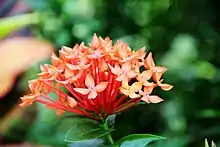Ixora
Ixora is a genus of flowering plants in the family Rubiaceae. It is the only genus in the tribe Ixoreae. It consists of tropical evergreen trees and shrubs and holds around 562 species.[1] Though native to the tropical and subtropical areas throughout the world, its centre of diversity is in Tropical Asia. Ixora also grows commonly in subtropical climates in the United States, such as Florida where it is commonly known as West Indian jasmine. Other common names include viruchi, rangan, kheme, ponna, chann tanea, techi, pan, siantan, jarum-jarum/jejarum, jungle flame, jungle geranium, and cruz de Malta, among others. The plants possess leathery leaves, ranging from 3 to 6 inches in length, and produce large clusters of tiny flowers in the summer. Members of Ixora prefer acidic soil, and are suitable choices for bonsai. It is also a popular choice for hedges in parts of South East Asia. In tropical climates they flower year round and are commonly used in Hindu worship, as well as in ayurveda and Indian folk medicine.
| Ixora | |
|---|---|
.jpg.webp) | |
| Ixora coccinea | |
| Scientific classification | |
| Kingdom: | Plantae |
| Clade: | Tracheophytes |
| Clade: | Angiosperms |
| Clade: | Eudicots |
| Clade: | Asterids |
| Order: | Gentianales |
| Family: | Rubiaceae |
| Subfamily: | Ixoroideae |
| Tribe: | Ixoreae |
| Genus: | Ixora L. |
| Type species | |
| Ixora coccinea | |
| Species | |
|
around 562, see text | |
| Synonyms | |
| Wikispecies has information related to Ixora. |
| Wikimedia Commons has media related to Ixora. |
Selected species
- For a full list, see List of Ixora species
- Ixora albersii K.Schum.
- Ixora backeri Bremek.
- Ixora beckleri Benth.
- Ixora brevipedunculata Fosberg
- Ixora calycina Thwaites
- Ixora chinensis Lam.
- Ixora coccinea L.
- Ixora elongata B.Heyne ex G.Don
- Ixora euosmia K.Schum.
- Ixora foliosa Hiern
- Ixora johnsonii Hook.f.
- Ixora jucunda Thwaites
- Ixora killipii Standl.
- Ixora lawsonii Gamble
- Ixora malabarica (Dennst.) Mabb.
- Ixora margaretae (N.Hallé) Mouly & B.Bremer
- Ixora marquesensis F.Br.
- Ixora mooreensis (Nadeaud) Fosberg
- Ixora nigerica Keay
- Ixora nigricans R.Br. ex Wight & Arn.
- Ixora ooumuensis J.Florence
- Ixora panurensis Müll.Arg.
- Ixora pavetta Andr.
- Ixora peruviana (Spruce ex K.Schum.) Standl.
- Ixora pudica Baker
- Ixora raiateensis J.W.Moore
- Ixora raivavaensis Fosberg
- Ixora rufa Müll.Arg.
- Ixora saulierei Gamble
- Ixora setchellii Fosberg
- Ixora st-johnii Fosberg
- Ixora stokesii F.Br.
- Ixora temehaniensis J.W.Moore
- Ixora umbellata Valeton
- Ixora yavitensis Steyerm.
Gallery









.JPG.webp) Whitish pink Ixora
Whitish pink Ixora.JPG.webp) Pink orange ixora
Pink orange ixora.JPG.webp) White Ixora
White Ixora.jpg.webp) White Ixora
White Ixora.jpg.webp) Young Ixora seeds
Young Ixora seeds.jpg.webp) Ripe Ixora seeds (red ones)
Ripe Ixora seeds (red ones) Red mini Ixora
Red mini Ixora Pink mini ixora
Pink mini ixora